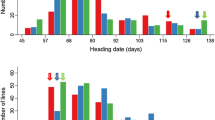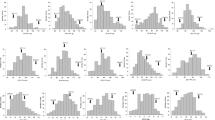Abstract.
Rice double-haploid (DH) lines of an indica and japonica cross were grown at nine different locations across four countries in Asia. Genotype-by-environment (G × E) interaction analysis for 11 growth- and grain yield-related traits in nine locations was estimated by AMMI analysis. Maximum G × E interaction was exhibited for fertility percentage number of spikelets and grain yield. Plant height was least affected by environment, and the AMMI model explained a total of 76.2% of the interaction effect. Mean environment was computed by averaging the nine environments and subsequently analyzed with other environments to map quantitative trait loci (QTL). QTL controlling the 11 traits were detected by interval analysis using mapmaker/qtl. A threshold LOD of ≥3.20 was used to identify significant QTL. A total of 126 QTL were identified for the 11 traits across nine locations. Thirty-four QTL common in more than one environment were identified on ten chromosomes. A maximum of 44 QTL were detected for panicle length, and the maximum number of common QTL were detected for days to heading detected. A single locus for plant height (RZ730-RG810) had QTL common in all ten environments, confirming AMMI results that QTL for plant height were affected the least by environment, indicating the stability of the trait. Two QTL were detected for grain yield and 19 for thousand-grain weight in all DH lines. The number of QTL per trait per location ranged from zero to four. Clustering of the QTL for different traits at the same marker intervals was observed for plant height, panicle number, panicle length and spikelet number suggesting that pleiotropism and or tight linkage of different traits could be the possible reason for the congruence of several QTL. The many QTL detected by the same marker interval across environments indicate that QTL for most traits are stable and not essentially affected by environmental factors.


Similar content being viewed by others
References
Albert BSB, Edwards MD, Stuber CW (1991) Isoenzymatic identification of quantitative trait loci in crosses of elite maize inbreds. Crop Sci 31:267–274
Austin DF, Lee M (1998) Detection of quantitative trait loci for grain yield and yield components in maize across generations in stress and nonstress environments. Crop Sci 38:1296–1308
Beavis WD, Grant D, Albertsen M, Fincher M (1991) Quantitative trait loci for plant height in four maize populations and their association with qualitative genetic loci. Theor Appl Genet 83:141–145
Causse MA, Fulton TM, Cho YG, Ahn SN, Chunwongse J, Wu K, Xiao J, Yu Z, Ronald PC, Harrington SE, Second G, McCouch SR, Tanksley SD (1994) Saturated molecular map of the rice genome based on an interspecific backcross population. Genetics 138:1251–1274
Champoux MC, Wang G, Sarkarung S, Mackill DJ, O'Toole JC, Huang N, McCouch SR (1995) Locating genes associated with root morphology and drought avoidance in rice via linkage to molecular markers. Theor Appl Genet 90:969–981
Cho YG, McCouch SR, Kuiper M, Kang M, Pot J, Groenen JTM, Eun MY (1998) Integrated map of AFLP, SSLP and RFLP markers using a recombinant inbred population of rice (Oryza sativa L.). Theor Appl Genet 97:370–380
Courtois B, Huang N, Guiderdoni E (1995) RFLP mapping of genes controlling yield components and plant height in an indica × japonica DH population. In: IRRI (ed) Fragile lives in fragile ecosystems. Proc Int Rice Res Conf IRRI, Los Banos, Philippines, pp 963–976
Gauch HG (1992) Model selection and validation for yield trials with interaction. Biometrics 44:705–712
Guiderdoni E, Gallinato E, Luistro J, Vergara G (1992) Anther culture of tropical japonica/indica hybrids of rice (Oryza sativa L.). Euphytica 62:219–224
Hayes PM, Liu BH, Knapp SJ, Chen F, Jones B, Blake T, Franckowiak J, Rasmusson D, Sorells M, Ullrich SE, Wesenberg D, Kleinhofs A (1993) Quantitative trait locus effects and environmental interaction in a sample of North American barley germplasm. Theor Appl Genet 87:392–401
Hemamalini GS, Shashidhar HE, Shailaja Hittalmani (2000) Molecular marker assisted tagging of morphological and physiological traits under two contrasting moisture regimes at peak vegetative stage in rice (Oryza sativa L.). Euphytica 112:69–78
Huang N, McCouch SR, Mew T, Parco A, Guiderdoni E (1994) Development of an RFLP map from a doubled haploid population in rice. Rice Genet Newslett 11:134–137
International Rice Research Institute (1988) Standard evaluation system for rice, 3rd edn, IRRI, Los Banos, Philippines
Knapp SJ, Bridges WC (1990) Using molecular markers to estimate quantitative trait locus parameters; power and genetic variances for un-replicated and replicated progeny. Genetics 126:769–777
Kurata N, Nagamura Y, Yamamoto A, Harushima Y, Sue N, Wu J, Antonnio BA, Shomura A, Shimizu T, lin SY, Inoue T, Fukuda A, Shimona T, Kuboki Y, Momma Y, Umehara Y, Yano M, Sasaki T, Minobe Y (1994) A 300 Kb interval genetic map of rice including 883 expressed sequence. Natl Genet 8:365–372
Lander ES, Botstein D (1989) Mapping Mendelian factors underlying quantitative traits using RFLP linkage maps. Genetics 121:185–199
Lebreton C, Lazic-Jancic V, Steed A, Pekic S, Quarrie SA (1995) Identification of QTL for drought responses in maize and their use in testing causal relationships between traits. J Exp Bot 46:853–865
Li Z, Pinson SRM, Stansel JW, Park WD (1995) Identification of quantitative trait loci (QTL) for heading date and plant height in cultivated rice (Oryza sativa L.). Theor Appl Genet 91:920–927
Lin H-X, Qian H-R, Zhuang J-Y, Lu J, Min S-K, Xiong Z-M, Huang N, Zheng K-L (1995) RFLP mapping of QTL for yield and related characters in rice (Oryza sativa L.) Theor Appl Genet 92:920–927
Lincoln SE, Daly MJ, Lander ES (1993) Mapping genes controlling quantitative traits with mapmaker/qtl1.1: a tutorial and reference manual. Whitehead Institute for Biomedical Research technical report, 3rd edn, Cambridge, Mass
McCouch SR, Cho YG, Yano M, Paul E, Blinstrub M, Morishima H, Kinoshita T (1997) Report on QTL nomenclature. Rice Genet Newslett 14:11–13
Paterson AH, Damon S, Hewitt JD, Zamir D, Rabinowitch HD, Lincoln SE, Tanksley SD (1991) Mendelian factors underlying quantitative traits in tomato: comparison across species, generations and environments. Genetics 127:181–197
Ricegenes (2000) http://genome.cornell.edu/
Shailaja Hittalmani, Shashidhar HE, Prashanth G. Bagali, Ning Huang, Sidhu JS, Singh VP, Khush GS (2002) Molecular mapping of quantitative trait loci for plant growth, yield and yield related traits across three diverse locations in a doubled haploid rice population. Euphytica 125:207–214
Shashidhar HE, Hemamalini GS, Hittalmani S (1999) Molecular marker-assisted tagging of morphological and physiological traits at the peak vegetative stage: two contrasting moisture regimes. In: Ito O, O'Toole, JC, Hardy B (eds) Genetic improvement of rice for water-limited environments. IRRI, Los Banos, Manila, Philippines, pp 239–256
Stuber CW, Lincoln SE, Wolf DW, Helenjaris T, Lander ES (1992) Identification of genetic factors contributing to heterosis in a hybrid from two elite maize inbred lines using molecular markers. Genetics 132:823–839
Temnykh S, Park WD, Ayres N, Cartinhour S, Hauck N, Lipovich L, Cho YG, Ishii T, McCouch SR (2000) Mapping and genome organization of microsatellite sequences in rice (Oryza sativa L.). Theor Appl Genet 100:697–712
Van Ooijen JW (1999) LOD significance thresholds for QTL analysis in experimental populations of diploid species. Heredity 83:613–624
Veldboom LR, Lee M (1996a) Genetic mapping of quantitative trait loci in maize in stress and nonstress environments: 1.Grain yield and yield components. Crop Sci 36:1310–1319
Veldboom LR, Lee M (1996b) Genetic mapping of quantitative trait loci in maize in stress and nonstress environments. II. Plant height and flowering. Crop Sci 36:1320–1327
Wang G, Mackill DJ, Bonman JM, McCouch SR, Champoux MC, Nelson RJ (1994) RFLP mapping of genes conferring complete and partial resistance to blast in a durable resistant rice cultivar. Genetics 136:1421–1434
Xiao J, Li J, Yuan L, Tanksley SD (1996) Identification of QTL affecting traits of agronomic importance in a recombinant inbred population derived from a sub-specific rice cross. Theor Appl Genet 92:230–244
Zhuang JY, Lin HX, Lu J, Qian HR, Hittalmani S, Huang N, Zheng KL (1997) Analysis of QTL × Environment interaction for yield components and plant height in rice. Theor Appl Genet 95:799–808
Acknowledgements.
We thank the Asian Rice Biotechnology Network and the Rockefeller Foundation, USA for the financial support (RF98001/698and 671 to SH). We are also grateful to all who have indirectly helped in conducting the trials at different locations.
Author information
Authors and Affiliations
Corresponding author
Additional information
Communicated by H.C. Becker
The order of authors is in accordance with their contribution towards conducting trials, generating data, data analysis and preparation of the manuscript
Rights and permissions
About this article
Cite this article
Hittalmani, S., Huang, N., Courtois, B. et al. Identification of QTL for growth- and grain yield-related traits in rice across nine locations of Asia. Theor Appl Genet 107, 679–690 (2003). https://doi.org/10.1007/s00122-003-1269-1
Received:
Accepted:
Published:
Issue Date:
DOI: https://doi.org/10.1007/s00122-003-1269-1




